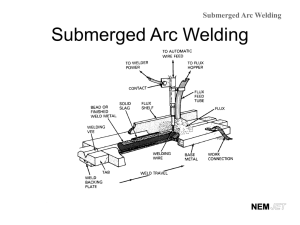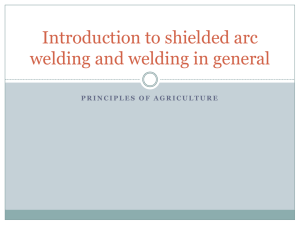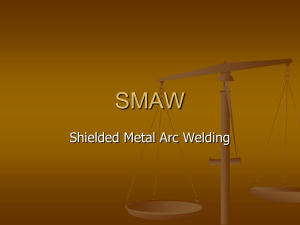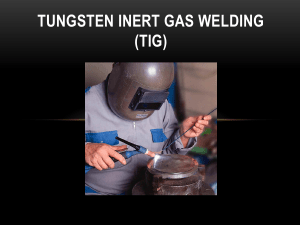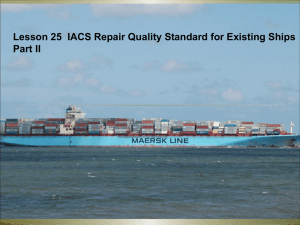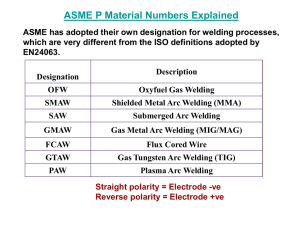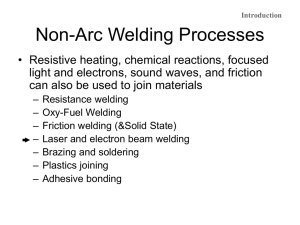SMAW Stick Welding PPT - Center - Center
advertisement
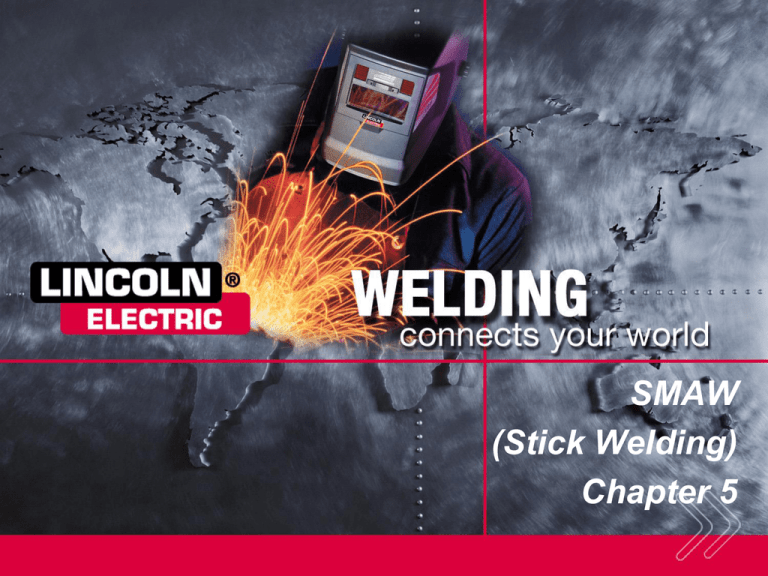
SMAW (Stick Welding) Chapter 5 SMAW Principles 2 SMAW Principles • The American Welding Society defines SMAW as Shielded Metal Arc Welding • SMAW: – Is commonly known as ‘Stick’ welding or manual arc welding – Is the most widely used arc welding process in the world – Can be used to weld most common metals and alloys 3 SMAW Welding Circuit • Current flows through the electrode cable, to the electrode holder, through the electrode, and across the arc • On the work side of the arc, the current flows through the base material to the work clamp and back to the welding machine 4 5 SMAW Process Let’s take a little closer look at the SMAW process… Electrode 1 Travel direction Shielding Gas 4 6 6 Slag Slag Weld Puddle 3 3 Weld Puddle 5 5 2 2 Arc Arc Solidified Weld Metal Solidified Weld Metal 6 Application Activity Let’s review the SMW process … 1 • 1 = __________ • 2 = __________ • 3 = __________ • 4 = __________ • 5 = __________ • 6 = __________ 4 6 3 2 5 7 1- The Electrode • Is a consumable - it gets melted during the welding process • Is composed of two parts – Core Rod (Metal Filler) Carries welding current Becomes part of the weld – Flux Coating Produces a shielding gas Can provide additional filler Forms a slag 8 2- The Arc Can you identify the weld joint and position being used? • An arc occurs when the electrode comes in contact with the workpiece and completes the circuit … like turning on a light! • The electric arc is established in the space between the end of the electrode and the work • The arc reaches temperatures of 10,000°F which melts the electrode and base material 9 3- Weld Puddle • As the core rod, flux coating, and work pieces heat up and melt, they form a pool of molten material called a weld puddle • The weld puddle is what a welder watches and manipulates while welding 1/8” E6013 at 125 Amps AC 10 4- Shielding Gas Shielding Gas 4 3 2 The shielding gas protects the molten puddle from the atmosphere while stabilizing the arc • A shielding gas is formed when the flux coating melts. • This protects the weld puddle from the atmosphere preventing contamination during the molten state 11 5- Solidified Weld Metal • As the molten weld puddle solidifies, it forms a joint or connection between two pieces of base material • When done properly on steel, it results in a weld stronger than the surrounding base metal 12 6- Slag • Slag is a combination of the flux coating and impurities from the base metal that float to the surface of the weld. • Slag quickly solidifies to form a solid coating • The slag also slows the cooling rate of the weld • The slag can be chipped away and cleaned with a wire brush when hard This welder chips the slag off of a weld during the repair of railroad tracks 13 Equipment 14 A complete SMAW Station • A complete shielded metal arc welding station consists of: – – – – – A Welding Machine An Electrode Lead An Electrode Holder A Workpiece Lead A Workpiece Ground Clamp 15 Welding Leads • Welding Leads: large diameter, super flexible leads (cables) are used to carry current from the welding machine to the work and back. – Electrode Lead: The lead from the machine to the electrode holder. – Work piece lead or ground lead: The lead from the work to the machine. • Leads are well-insulated with rubber and a woven fabric reinforcing layer. • Leads are subjected to considerable wear and should be checked periodically for breaks in the insulation. 16 Welding Leads • Leads are produced in several sizes. – The smaller the number, the larger the diameter. • The lead must be flexible to permit easy installation of the cable, and to reduce the strain on the arc welder’s hand when welding. • To produce this flexibility as many as 800 – 2500 fine wires are used in each cable. • The SAME diameter electric cable must be used on both the electrode and work piece leads. – The length of the lead has considerable effect on the size to be used for certain capacity machines. – Use short leads to minimize current loss due to the lead resistance. 17 Electrode Holders • Electrode Holder: the part of the arc welding equipment held by the operator when welding. Holds the electrode. – Many different styles and models are available, but they all have similar characteristics. 18 Weld-Cleaning Equipment • It is very important that the base metals in weldments be cleaned prior to welding. – It is difficult to weld dirty or corroded surfaces. Resulting welds will normally be of poor quality. • Weldments: A unit composed of an assemblage of pieces welded together. 19 Chipping Hammer • Chipping hammers are often double-ended. – One end is shaped like a chisel for general chipping. – The other end is shaped like a pick, for reaching into corners and narrow spaces. 20 Headgear • Arc welding requires the use of special equipment to protect skin surfaces, such as the hands, face and eyes. • The Occupational Safety and Health Administration (OSHA) requires the use of a hard hat with the arc welding helmet on construction sites. 21 Arc Welding Helmet • An Arc Welding Helmet is used to protect the face and eyes. – It is mounted and supported on the head – Made of fiber, plastic or fiberglass and is formed in a shape that covers the front half of the head. – Headbands on the helmets are adjustable – There is an tension adjustment that keeps the helmet up. You can adjust the tension so a slight nod of the head will allow the helmet to rotate down over your face 22 Welding Helmet Lenses • A good grade of colored arc welding filter lens will remove approximately 99.5% of the infrared rays and 99.75% of the ultraviolet rays from the light emitted by the arc. • U.S. Bureau of Standards developed recommended shades for various arc welding applications. – Shade number 10, 12 and 14 are the common ones used for SMAW. – The higher the shade number, the lower the transmission of infrared or ultraviolet rays. – Autodarkening: Helmets have been developed that have a battery-powered photoelectric cell built in. The lens is clear until an arc is struck. The circuitry of the photoelectric cell then instantly darkens the lens. 23 Arc Safety • Excess ultraviolet rays may cause eye pain for 8 to 18 hours after exposure. • Infrared and ultraviolet light rays can severely injure the eyes; every precaution should be taken to shield the eyes from these rays. 24 25 Shield • A shield is used in a metal shop for jobs such as grinding and cutting. – Similar design to a welding helmet. – Headbands on the shield are adjustable. – Made of fiber, plastic or fiberglass and is formed in a shape that covers the front half of the head. – Can not be used to weld with. 26 Safety Glasses • A welder must wear safety glasses at all time under a welding helmet or shield. • They enable the operator to set up work, chip welds and still have eye protection from flying particles. 27 Clothing • While an arc weld is in progress, the molten flux and the metal itself sometimes spatter for a considerable distance around the joint being welded. • The operator must, therefore, be protected from the danger of being burned by these hot particles. • Such clothing as gloves, cap, cape, shoes and aprons. • All these clothing articles should be made of leather or approved clothing for welding. 28 Welding Gloves • Welding gloves are made of leather and are wore during welding. • Gloves should be worn to cover the hands and wrists and to prevent “sunburn” – During the welding process, skin not covered will be exposed to UV rays and sunburned. 29 Welding Cap • A welding cap can be worn underneath the welding helmet. • Protects top of head from spatter. • Helpful when welding overhead. 30 Welding Cape • A welding cape is worn to protect shoulders and arms from spatter. 31 Welding Boots • Welding boots should be made of leather and high topped. • NO tennis shoes 32 Welding Pants • Pants should be jean/coverall material. • Pants worn by the welder should not have cuffs. • Cuffs may catch burning particles as they fall. 33 Welding Aprons • A welding apron can be worn over a long sleeve shirt during welding to protect the front of the operator. 34 AWS Classification of SMAW Electrodes 35 SMAW Electrodes • Electrodes have a solid metal wire core and a thick flux covering (coating). • These electrodes are identified by the wire diameter and by a series of letters and numbers. • These letters and numbers identify the metal alloy and the intended use of the electrode. • The common diameters are 1/16”, 3/32”, 1/8”, 5/32”, 3/16”, 7/32”, 1/4”, 5/16”, and 3/8”. – Available in lengths from 9” to 18”. Most common is 14”. • The electrodes are usually purchased in 50 lb. packages 36 SMAW Electrodes • SMAW electrodes are produced for welding on many metals and alloys including: – – – – – – – – Carbon Steels Low-Alloy Steels Corrosion-Resistant Steels Cast Irons Aluminum and Aluminum alloys Copper and Copper Alloys Nickel and Nickel Alloys Surfacing • Alloy: Pure metal that has additional metal or nonmetal elements added while molten. The alloy has mechanical properties that are improved from the pure metal. 37 SMAW Electrodes • Flux: The covering on a shielded metal arc welding electrode • The flux on the electrode performs many different functions. – – – – – 1. Producing a protective gas around the weld area. 2. Providing fluxing elements and deoxidizers. 3. Creating a solid coating over the weld as it cools. 4. Establishing electrical characteristics. 5. Adding alloying elements. 38 1. Protective Gas • During the arc process, some of the flux covering changes to neutral gases or reducing gases such as carbon monoxide (CO) or hydrogen (H). – These gases prevent oxygen from coming in contact with the molten metal. 39 2.Fluxing Elements • The covering also contains special fluxing ingredients that work to remove impurities from the molten metal. – Impurities are floated to the top of the molten weld pool. 40 3. Solid Coating • Slag: As the electrode flux coating residue cools, it forms a coating of material over the weld called slag. – Prevents the air from contacting the hot metal. – Allows the weld to cool more slowly and helps prevent a hard, brittle weld. 41 4. Electrical Characteristics • When welding with AC, the current changes direction and actually stops 120 times per second. • To maintain an arc as the current changes directions, ingredients are added to the covering of the electrode to create an ionized gas. – This gas allows good arc stability when welding with AC. 42 5. Alloying Elements • Alloying elements are added to the weld pool as the covering is melted. – These electrodes deposit metal into the weld at a faster rate than standard electrodes. • A good flux-covered electrode can produce a weld that has excellent physical and chemical properties. 43 Electrode Classification • The American Welding Society has developed a series of identifying number classifications. • Uses four or five digits. 44 AWS Classification of SMAW Electrodes E70XX Electrode Tensile in Ksi Welding Position: 1 = All Position, 2 = Flat & Horizontal Type of Current and Coating 45 Tensile Strength • E: indicates a welding electrode used in arc welding. E70XX 46 Tensile Strength • The first two or three digits represent the tensile strength E70XX – E70XX = 70,000 psi, E100XX = 100,000psi – Psi: Pounds per square inch • May also be shown as ksi – Ksi: Kilopounds per square inch – 70 ksi = 70,000 psi 47 Welding Position • The second digit from the right indicates the recommended position of the joint that the electrode is designed to weld. E70XX – EXX1X: Will weld in all positions – EXX2X: Are used for welds in the flat or horizontal welding position only. 48 Type of Current and Coating • The last two digits need to be looked at together. • The two digits give the welder information on the electrode covering, current to use and position to use the electrode. • *Refer to chart for more information E70XX 49 50 CHAPTER 6 51 Electricity • Electricity flows in two ways: Either in an alternating current (AC) or in a direct current (DC). • Electricity or “current” is nothing but the movement of electrons through a conductor, like a wire. • DC: The electrons flow steadily in a single direction, or “forward”. • AC: Electrons keep switching directions, sometimes going “forward” and then going “backward” 52 Setting the Machine • https://www.youtube.com/watch?v=4XsllbOLIDo • http://www.millerwelds.com/resources/calculators/stick_ amperage_calculator.php 53 Striking an Arc • To begin the SMAW Process, you must first strike an arc. This can be done using one of the following techniques: – Scratch start – scratch the electrode on the base metal like a match – Tap Start – tap the rod against the base metal 54 Work Angle 90° • The work angle is the angle between the electrode and the work as depicted on the left • Work angles can vary depending on the position the weld is being made in 55 Travel Angle 20-30° • Also commonly called Lead Angle • The travel (lead) angle is the angle between the electrode and the plane perpendicular to the weld axis 56 Arc Length • After striking the arc, maintain a 1/8” distance between the electrode and the workpiece – If the arc length becomes too short, the electrode will get stuck to the workpiece or ‘short out’ – If the arc length becomes too long; spatter, undercut, and porosity can occur – A proper arc length will produce a crackling sound like bacon frying. Arc Length = 1/8” 57 Travel Speed • The travel speed is the speed at which the electrode moves along the base material while welding – Too fast of a travel speed results in a ropey or convex weld – Too slow of a travel speed results in a wide weld with an excessive metal deposit End of Weld The travel speed impacts the shape of the bead. 58 Filling the Crater • At the end of the weld, the operator breaks the arc which creates a ‘crater’ • Use a short pause or slight back step at the end of the weld to fill the crater • Large craters can cause weld cracking Back stepping is a short move in the opposite direction of weld travel 59 Restarting a Bead • Here is the proper technique for restarting a weld: 1. Strike Arc Here 2. Move Electrode to Crown of Crater 3. Resume Forward Travel 60 Cleaning • Slag must be removed after completing the bead, prior to welding over a bead, and before painting. • If slag is not removed before restarting a weld or before welding over a bead, the resulting weld will have slag inclusions. – Slag inclusions: Are pieces of slag trapped, or included, in the weld. • Remove slag with a wire brush or chipping hammer. 61 Joint Designs • The five basic joint designs are: – – – – – Butt Lap Corner T-joint Edge 62 Joint Designs 63 SMAW Safety • Fumes and Gases can be dangerous – Keep your head out of the fumes – Use enough ventilation, exhaust at the arc, or both, to keep fumes and gases from your breathing zone and the general area – The SMAW process can withstand wind and exhaust near the arc from ventilation equipment • Electric Shock can kill – to receive a shock your body must touch the electrode and work or ground at the same time – Do not touch the electrode or metal parts of the electrode holder with skin or wet clothing • Arc Rays can injure eyes and skin - Choose correct filter shade. 64 Center-Stanton Agriculture Welding • Get started working right away when class starts. • Change into your welding clothes quickly. – If you forget them you will receive a zero for the day and receive a paper assignment. • Last 10 minutes is used for cleaning. – You MUST clean the entire time. – Welding stations and work areas must be kept clean. • Do NOT throw metal and electrodes in the garbage. • Make sure all welding machines are turned off. • NEVER leave hot metal lying around. 65 Advantages of SMAW • • • • Low initial cost Portable Easy to use outdoors All position capabilities • Easy to change between many base materials What safety precautions should be taken by these welders? 66 Limitations of SMAW • Lower consumable efficiency • Difficult to weld very thin materials • Frequent restarts • Lower operating factor • Higher operator skill required for SMAW than some other processes Building a barge in a large shipyard 67 Troubleshooting Welds 68 Weld flaws and defects • Completed welds may have a variety of flaws. • A welder may find the following weld flaws and defects: – – – – Poor weld proportions Undercutting Lack of penetration Surface flaws and defects. 69 70 Troubleshooting Welds A B C D E F G These welds were cut and etched with nitric acid to show penetration 71 Lesson Plans 72 SMAW Lesson #1 • Objective: Strike and establish an arc • Equipment: – Single Process – Constant Current Power Source Idealarc 250 and accessories Precision TIG 225 and accessories – Multi-Process Power MIG 350 MP • Material: – Mild Steel Plate 1/8” or thicker – 1/8” Fleetweld 5P+ (E6010) for DC or Fleetweld 180 (E6011) for AC 73 SMAW Lesson #2 • Objective: To run a straight bead on flat plate and to fill the crater • Equipment: – Single Process Constant Current Power Source Idealarc 250 and accessories Precision TIG 225 and accessories – Multi-Process Power MIG 350 MP • Material: – Mild Steel Plate 3/16” or thicker – 1/8” Fleetweld 37 (E6013) Good Poor 74 SMAW Lesson #4 • • Objective: To build a pad Equipment: – Single Process - Constant Current Power Source Idealarc 250 and accessories Precision TIG 225 and accessories – Multi-Process Power MIG 350 MP • Material: – Mild Steel Plate 3/16” or thicker – 1/8” Fleetweld 37 (E6013) 75 SMAW Lesson #5 • • Objective: To make a fillet weld on a lap joint in the horizontal position (AWS Position 2F) Equipment: – – • Single Process - Constant Current Power Source Idealarc 250 and accessories Precision TIG 225 and accessories Multi-Process Power MIG 350 MP Material: – – Mild Steel Plate - 10 gauge 1/8” Fleetweld 5P+ (E6010) for DC or Fleetweld 180 (E6011) for AC 2F Top View Side View 76 SMAW Lesson #6 • • Objective: To make a fillet weld on a tee joint in the horizontal position (AWS Position 2F) Equipment: – Single Process - Constant Current Power Source Idealarc 250 and accessories Precision TIG 225 and accessories – Multi-Process Power MIG 350 MP • Material: – Mild Steel Plate - 10 gauge – 1/8” Fleetweld 5P+ (E6010) for DC or Fleetweld 180 (E6011) for AC 2F 77 SMAW Lesson #7 • • Objective: To make a fillet weld on a tee joint in the horizontal position (AWS Position 2F) Equipment: – – • Single Process - Constant Current Power Source Idealarc 250 and accessories Precision TIG 225 and accessories Multi-Process Power MIG 350 MP Material: – – Mild Steel Plate - 10 gauge 1/8” Excalibur 7018 (E7018) for DC or Lincoln 7018AC (E7018) for AC 2F 78 SMAW Lesson #8 • • Objective: To make a three pass fillet weld on a tee joint in the horizontal position (AWS Position 2F) Equipment: – – • Single Process - Constant Current Power Source Idealarc 250 and accessories Precision TIG 225 and accessories Multi-Process Power MIG 350 MP Material: – – Mild Steel Plate – ¼” 1/8” Excalibur 7018 (E7018) for DC or Lincoln 7018AC (E7018) for AC 2F 79 SMAW Lesson #9 • • Objective: To make a fillet weld on a lap joint in the vertical position welding down (AWS Position 3FD) Equipment: – – • Single Process - Constant Current Power Source Idealarc 250 and accessories Precision TIG 225 and accessories Multi-Process Power MIG 350 MP Material: – – Mild Steel Plate - 10 gauge 1/8” Fleetweld 37 (E6013) 3FD 80 SMAW Lesson #10 • • Objective: To make a fillet weld on a tee joint in the vertical position welding down (AWS Position 3FD) Equipment: – – • Single Process - Constant Current Power Source Idealarc 250 and accessories Precision TIG 225 and accessories Multi-Process Power MIG 350 MP Material: – – Mild Steel Plate - 10 gauge 1/8” Fleetweld 5P+ (E6010) for DC or Fleetweld 180 (E6011) for AC 3FD 81 SMAW Lesson #11 • • Objective: To make a fillet weld on a lap joint in the overhead position (AWS Position 4F) Equipment: – – • Single Process - Constant Current Power Source Idealarc 250 and accessories Precision TIG 225 and accessories Multi-Process Power MIG 350 MP Material: – – Mild Steel Plate - 10 gauge 1/8” Fleetweld 5P+ (E6010) for DC or Fleetweld 180 (E6011) for AC 4F 82 SMAW Lesson #12 • • Objective: To make a fillet weld on a tee joint in the overhead position (AWS Position 4F) Equipment: – – • Single Process - Constant Current Power Source Idealarc 250 and accessories Precision TIG 225 and accessories Multi-Process Power MIG 350 MP Material: – – Mild Steel Plate - 10 gauge 1/8” Fleetweld 5P+ (E6010) for DC or Fleetweld 180 (E6011) for AC 4F 83 SMAW Lesson #13 • • Objective: To make a single pass fillet weld on a tee joint in the vertical position welding up (AWS Position 3F) Equipment: – – • Single Process - Constant Current Power Source Idealarc 250 and accessories Precision TIG 225 and accessories Multi-Process Power MIG 350 MP Material: – – Mild Steel Plate – 1/4” 1/8” Fleetweld 5P+ (E6010) for DC or Fleetweld 180 (E6011) for AC 3F 84 SMAW Lesson #14 • • Objective: To make a three pass fillet weld on a tee joint in the vertical position welding up (AWS Position 3F) Equipment: – – • Single Process - Constant Current Power Source Idealarc 250 and accessories Precision TIG 225 and accessories Multi-Process Power MIG 350 MP Material: – – Mild Steel Plate – 1/4” 1/8” Fleetweld 5P+ (E6010) for DC or Fleetweld 180 (E6011) for AC 3F 85 SMAW Lesson #15 • • Objective: To make a single pass fillet weld on a tee joint in the vertical position welding up (AWS Position 3F) Equipment: – – • Single Process - Constant Current Power Source Idealarc 250 and accessories Precision TIG 225 and accessories Multi-Process Power MIG 350 MP Material: – – Mild Steel Plate – 1/4” 1/8” Excalibur 7018 (E7018) for DC or Lincoln 7018AC (E7018) for AC 3F 86 SMAW Lesson #16 • • • Objective: To make a three pass fillet weld on a tee joint in the vertical position welding up (AWS Position 3F) Equipment: – Single Process - Constant Current Power Source Idealarc 250 and accessories Precision TIG 225 and accessories – Multi-Process Power MIG 350 MP Material: – Mild Steel Plate – 1/4” – 1/8” Excalibur 7018 (E7018) for DC or Lincoln 7018AC (E7018) for AC 3F 87 AWS Connection 88 AWS Connection • The SMAW Welding Unit of study incorporates the following information taken from the AWS EG 2.0 requirements: – Set up for SMAW operations on carbon steel – Operate SMAW equipment on carbon steel – Make SMAW fillet welds on carbon steel 89 English, Math, and Science Connection 90 National Academic Standards Crosswalk • The unit, just completed, has covered parts of academic content listed in the National Academic Standards as follows: – NM-PROB.CONN.PK-12.3: Recognizes and applies mathematics in contexts outside of mathematics. – NLA-STANDARD 1: Uses the general skills and strategies of the writing process. – NLA-STANDARD 7: Uses reading skills and strategies to understand and interpret a variety of informational texts. – NS-PHYSICAL SCIENCE: (Experiences) interactions of energy and matter. 91 SMAW Equipment Set Up 1. Turn power supply on 2. Connect work clamp 3. Select electrode a. Type b. Diameter 4. Adjust output a. Polarity b. Amperage 6. Insert electrode into electrode holder 92 SMAW Process Variables • Settings on the machine – Polarity : AC, DC+, DC– Amperage Output • Operator Controlled Variables – – – – Work Angle Travel Angle Arc Length Travel Speed A straight AC machine will not have a polarity switch like this AC/DC machine 93

